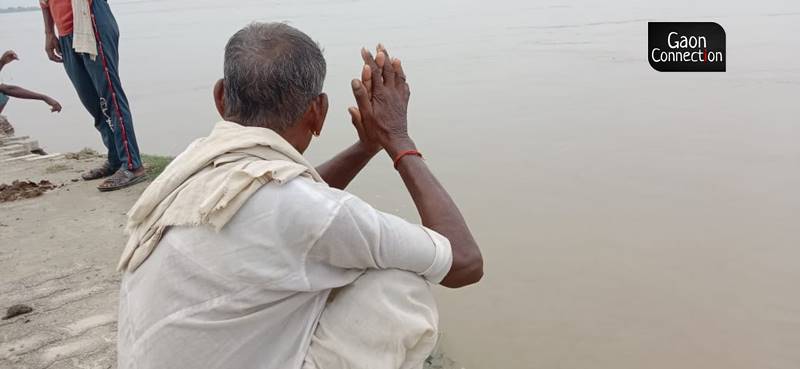Sitapur and Barabanki, Uttar Pradesh
Squatting on the edge of the overflowing Ghaghra river, 55-year-old Keedi Ram spends most of his time staring at the vast ocean of the floodwaters that has engulfed his 12 bigha land (almost two hectares). “Bina zameen ke ho gaye ab, ka ki jaaye bhaiya (I am landless now, have no idea what to do now),” a resident of Akhri village in Rampur-Mathura block in Sitapur, told Gaon Connection.
About a week back, Keedi Ram was counted among the landed farmers in his village, which is located 77 kilometres from state capital Lucknow. But now he is bhoomiheen (landless).
Ghaghra river, a tributary of Ganga river, is facing massive floods and has inundated almost 40 villages in the districts of Barabanki and Sitapur. Villagers have lost their homes, farmlands and stored grains and complain little support has come from the state government.
Explained: How air pollution affects monsoon rains in India
A total of 644 villages across 16 districts in Uttar Pradesh are flood-hit right now as all the major rivers, including Ganga, Yamuna, Ghaghra, Sharda, and Chambal are swollen due to heavy monsoon rainfall. Today, September 2, Ghaghra river is flowing at severe flood level at several locations in the state.
“No sarkaari afsar (administrative officer) has cared enough to visit my village and know about our miseries. It’s only during chunaav (elections) that neta logan (politicians) remember us and shamelessly come to seek votes as if we have been living happily all along,” complained 40-year-old Rajni, a resident of Belhari village in the Fatehpur block of Barabanki which is also flood-hit.
Also Read: As Ghaghra erodes land and washes away livelihood, flood victims begin to migrate
“I have sent my little kids to my relative’s house as there is not much to eat here and water has entered inside my house… I fear for their lives as they can fall from the chaarpaayi (charpoy) and drown in knee-deep water,” said the worried mother. “There has been no relief material or food grains provided to us for 11 days straight. Two days back I received some supplies of rice but how long would it take to support the family,” Rajni added.
However, Rajeev Kumar Shukla, Deputy District Magistrate of Barabanki maintained that the flood-affected villagers were being provided with the required aid.
“People in the affected villages are being provided with relief measures. We have ensured that boats are available in these areas for easy transportation. Aid in the form of food supplies are also being provided,” he said in a statement.
‘Embankment desperately needed’
The villagers living on the bank of the Ghaghra river told Gaon Connection that had there been an embankment to protect the overflowing river from submerging their villages, they would have been far better.
“The villages along the Ghaghra need a thokar (embankment) to protect them from the overflowing river. If that happens, we will not have to face this destruction every year,” Ramgopal Shukla, a resident of Sarsanda village in Barabanki, told Gaon Connection. But I don’t know why the government cannot think of this; we have been demanding a thokar for a long while but nobody listens, he added.
Also Read: UP floods ground report: 406 villages inundated in Mirzapur as Ganga flows above danger mark
“People here build their houses every year and in the rainy season, they have to relocate. All this is detrimental to development. How would we do anything else if survival itself is a challenge every year?” Shukla asked.
The floods are especially worrying during the night, said flood-hit villagers.
Fatima, a 40-year-old resident of Kachnapur village in Barabanki, uses a cane to walk outside her thatched roof house as there is knee-deep water and a single fall can result in a serious injury.
“There’s a deep pit right outside my house. The power supply was cut off as the electric pole got damaged due to the floods. It’s pitch dark at night and there’s constant fear of snakes and scorpions,” Fatima told Gaon Connection. “If somebody falls sick here, the only way to receive medical aid is four kilometres away and it is to be reached by boat. We pray that nobody falls sick during these times,” she added.
Flood relief measures
On August 28, Barabanki district magistrate Adarsh Singh and Member of Parliament from Barabanki Upendra Singh Rawat inspected the Hetmapur area on the Ghaghrabank.
Official statement informed that a total of 360 ration food kits were distributed amongst the villagers. Both the officials also met the villagers and sought to know about their living conditions.
“The officials have been instructed to estimate the losses incurred by the affected population,” the press statement noted.
Meanwhile, state chief minister Yogi Adityanath yesterday directed the officials to ensure that the flood aid is not delayed to the villagers suffering in deprivation.



















